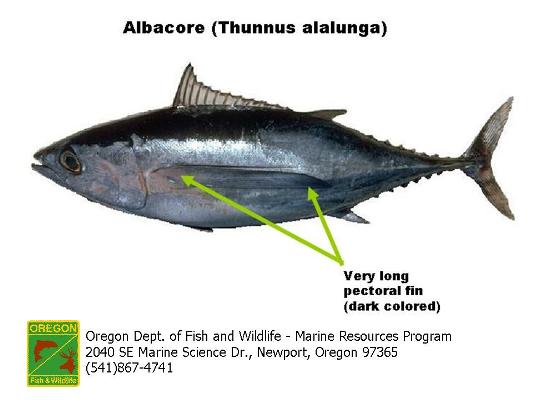Adaptation
There are many ways that the Albacore
tuna have adapted to their environment.
First off, Albacore tuna are continuous swimmers which means they
are always swimming at rapid speeds, especially during migration
periods. They are able to reach speeds up to 80 kilometers per
hour. Since they must always be swimming, they must possess
many characteristics to help them do this. They have long skinny
bodies which allows for speed in the ocean. They have tiny,
cycloid scales as well, which allow for smooth skin. They
also possess streamlined fins. The streamlined fins allow for
extremely quick movements for the Albacore tuna. One reason for
their long shape is due to their long pectoral fin.
Also, they must get a good kick to start their
movement and then be able to maintain their speeds. To be able to do
this, they have developed strong tail fins that seem to be fork
shaped. Albacore tuna must also adapt to the loss of many structures that
help with the uptake of oxygen. Most fish have some type of
structure or structures that are used to pump water over their gills
in order to obtain oxygen. However, Albacore tuna have lost these
structures and also do not possess a swim bladder. Because of this,
the tuna must have adaptations to avoid death. Albacore tuna swim
with their mouths open to help receive oxygen-rich water. This helps
to make the water go against their gills so they can receive the
oxygen. Another adaptation that they have is a higher blood
pressure. With this, they also have high hemoglobin concentrations which
help with the absorption of oxygen. Another adaptation that they
have to help with the absorption of oxygen is an extremely well
developed circulatory system. This system helps to increase muscular
activity and also helps to reduce heat loss. They tend to have a
higher body temperature than the temperature of the water, which
aides in a high metabolic rate. Further adaptations that the Albacore
tuna possess is their coloration. They are dark blue on top and have
a white underside that helps them blend into the surrounding water
which hides themselves from the ocean's predators.
Albacore tuna must also adapt to the loss of many structures that
help with the uptake of oxygen. Most fish have some type of
structure or structures that are used to pump water over their gills
in order to obtain oxygen. However, Albacore tuna have lost these
structures and also do not possess a swim bladder. Because of this,
the tuna must have adaptations to avoid death. Albacore tuna swim
with their mouths open to help receive oxygen-rich water. This helps
to make the water go against their gills so they can receive the
oxygen. Another adaptation that they have is a higher blood
pressure. With this, they also have high hemoglobin concentrations which
help with the absorption of oxygen. Another adaptation that they
have to help with the absorption of oxygen is an extremely well
developed circulatory system. This system helps to increase muscular
activity and also helps to reduce heat loss. They tend to have a
higher body temperature than the temperature of the water, which
aides in a high metabolic rate. Further adaptations that the Albacore
tuna possess is their coloration. They are dark blue on top and have
a white underside that helps them blend into the surrounding water
which hides themselves from the ocean's predators.
The final adaptation that the Albacore tuna possess is a process known as countercurrent exchange. This process helps increase the amount of oxygen intake to help them survive. In this process, water flows in opposite channels from the blood that is found in the capillaries. Low oxygen blood will flow down the capillaries and meet up with the water at the end. The blood runs into water with higher concentrations of oxygen as it runs down the capillaries. Thus, a diffusion gradient occurs where oxygen will flow into the blood, giving the fish more oxygen. As seen in the following image, countercurrent flow is far more effective in diffusion of oxygen than concurrent flow is.
The adaptations that the Albacore tuna have evolved have helped them to be able to survive and continue to strive in their habitats today.
You can find many other interesting aspects of the Albacore tuna by visiting the interactions page.

